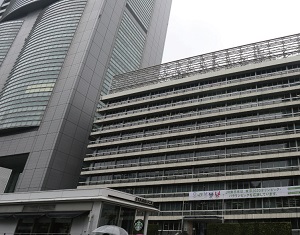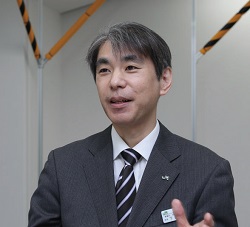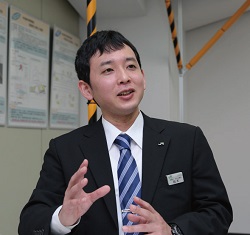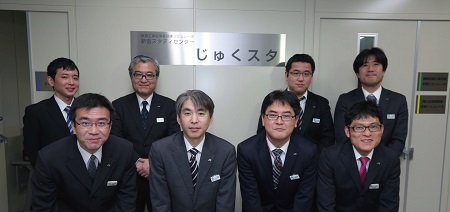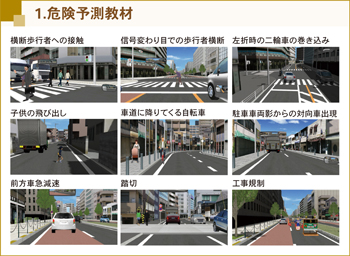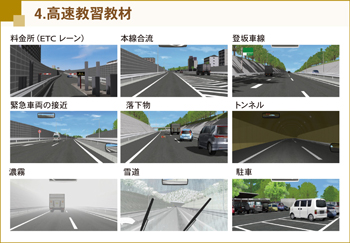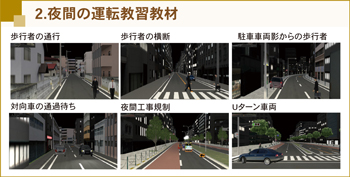|
TESCO is largely composed of 4 divisions: 1) Energy-related division for constructing or updating facilities for providing a huge amount of electrical power essential for operation of trains and stations etc. safely and stably, including facilities of power-generation and transformation of electrical energy, grid, electric car track (overhead wire), and power distribution (electric light power); 2) Train-control-related division for introducing or updating signal systems and operation management system to support safe and stable transport of trains; 3) Information-communication-related division for constructing and updating the train radio system to connect the commander and crew, and communication network etc. to collect and transmit disaster prevention information (wind speed indicator or seismometer) or provide various information to users and employees; and 4) Railway-administration-related division for performing a wide range of general affair works to support smooth operation of these services. With the head office adjacent to Shinjuku Station as its core, about 1,000 employees are positioned over 7 electrical system construction areas of Tokyo, Shinjuku, Shinagawa, Yokohama, Hachioji, Chiba, and Niigata.
Emphasis on Human Resource Development Using "Juku-Suta" to the
Fullest Based on the Concept of Safety Planning
"Safety is not performed by the organization alone. The utmost issue
is how to raise each person's consciousness," says Deputy General
Manager Shimoyama. As such, Safety Planning Office guides safety within
TESCO unitarily to materialize the motto that JR East upholds: "ultimate
safety levels (no fatal and injury accident of passengers, and no fatal
accident of the employees)". He says that along with human resource
development to create culture to give top priority to safety, when an accident
has occurred, they put emphasis most on deepening the true nature and cause
of the actual accident and take proper measures to prevent recurrence.
The Company has formulated "The 5-year Safety Plan" to pursue
the "ultimate safety levels" and work out countermeasures for
the group as one body. In this, “Group Safety Plan 2023” (for 5 years from
2019 fiscal year) formulated in Nov. 2018 upholds evolution and renovation
of "safe action" and "safety management" of each employee
as well as positive utilization of new technologies for these as its pillars.
With this situation as background, Safety Planning Office is keeping on
actions to explore new educational approach using the 3D VR simulator.
In the Office, Mr. Yuya Inamoto, assistant Manager, Safety planning group says that his most important job is to work out countermeasures for preventing recurrence of troubles in particular and specify them such as by making rules. He states that development of educational training facilities for "Juku-suta" mentioned at the opening is another new main job.
Whereas originally TESCO depended on education on desktop or real site, or using on-site training facility for safety education, JR East has been paying attention to the advantages of VR technologies for several years. From the viewpoint of apprehension of the potential of its application as well as risk aversion, moods for positive deployment of the training simulator applying VR were increasing.
Under such circumstances, TESCO opened "Juku-Suta", a facility specialized for practical training and safety education on the 4th floor of JR Shinjuku Bldg. in Oct. 2018. The following devices are installed there. 1) "Simulator for training train protection" for training response ability to properly perform judgment of train protection and device operation when something abnormal is found, 2) "Simulator for training procedure of track closure work" for representing derailment accidents and learning points of preventing accidents such as chain of command and conversation for confirmation, 3) "Simulator for bodily sensing power pole collapse event" for developing sensitivity for dangerous conditions of facilities by changing the inclination of the power pole etc., 4) "Simulator for training power failure construction procedure" for representing events likely to occur in power failure construction, and training to perform a series of proper procedure, and 5) "Driving simulator" using UC-win/Road DS for developing sensitivity for risk prediction to prevent traffic accidents while driving work vehicle. Their operation for the employees of the Company and group companies has started.
Risk-prediction simulator based on UC-win/Road
It was the beginning of 2017 when introduction of DS into Safety Planning Office was examined for the purpose of preventing traffic accidents caused by employees who drive vehicles for work. They collected information about DS through the Internet etc. In the spring of the year, they focused on UC-win/Road DS based on their expectation of its full product lineup and after-service including its specifications. Touching the actual machine in the showroom of FORUM8 headquarters, they realized the motion of 3D VR without sense of incongruity and good operability, easiness of switching settings for day and night or bad weather, and functions capable of representing the scenes to urge the driver to predict risks and recover driving sense (Mr. Inamoto). It was decided to introduce it in Feb. 2018.
| Meanwhile, idea of opening "Juku-Suta" surfaced as mentioned before. In parallel with its preparation, a scenario of the risk-prediction simulator during driving work vehicle ("Driving Simulator”) was arranged. It was completed by the opening of "Juku-Suta" in Oct. The DS is accommodated at one of its corners.
"As it is a section of electric construction, we often go to the work site at night, not to mention the daytime". Besides, though new employees have few driving experiences, they tend to be in the condition of being obliged to drive work vehicles when they are positioned at the site first after joining the Company. On the other hand, though external facilities such as the police have been used conventionally, there are restrictions of the number of people or time. Consequently, intention of installing a dedicated simulator within the office has been formed, says Mr. Inamoto.
|
|
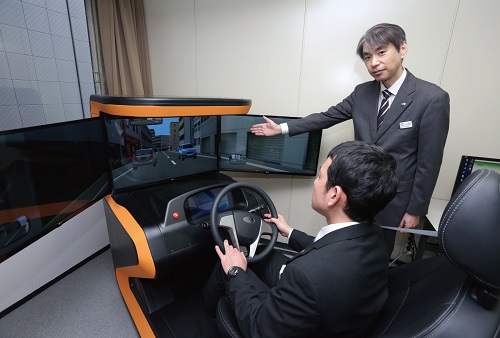 |
Many employees use it for safe driving training based on the scenarios
with diverse kinds of risk assumptions |
|
This DS basically adopts the contents suitable for the purpose from the Safer Driving Educational Material based on the certification standards for driving simulators. It is so organized as to allow the user to experience various kinds of risk prediction through traveling in urban areas, expressways, and mountain path.
According to Mr. Shimoyama, they want to utilize it also as part of new employee education from April, when fiscal years change, and in this sense, it is required to figure out some way to have the user repeat experiences, for example, by newly reflecting timely elements such as an issue of driving in the opposite direction.
Points of utilizing VR for Safety Measures
"Use of VR enables us to reproduce any kind of scenes (considered
to be necessary for safety education)."
Therefore, through daily operations, they considered some problems: e.g.
what kind of places are dangerous, or what is the point to keep safety.
Mr. Inamoto says that it is important to grasp these beforehand for using
VR effectively, based on his experience to work for building up the DS
for educating the employees.
Furthermore, as the responsible person of the division having jurisdiction over safety education of TESCO and effective operation of the DS, Mr. Shimoyama talks about difficulty of keeping and improving the safety level of an organization.
"Safety level drops down without doing anything."
Therefore, "I think that important points are how to keep on performing the training with VR (which is one of the countermeasures) regularly, and how to enrich the contents (of the simulator itself to that the users don't get bored)".
Standard scenarios for safer driving simulator, based on the certification standards for driving simulators
1) Lesson on hazard perception (urban area course, 23 scenes of risks and
requiring attention)
2) Lesson on nighttime driving (24 scenes for learning knowledge and skill
of nighttime driving)
3) Lesson on sudden braking (based on the brake stopping distance on the
dry / wet / frozen road surface)
4) Lesson on driving on the highway (18 scenes for learning driving technique)
5) Lesson on location-specific conditions (roads on the basis of local
characteristics such as climate and topographic features)
6) Lesson on driving in bad condition (driving skill learning under 11
points of bad conditions) |
|
